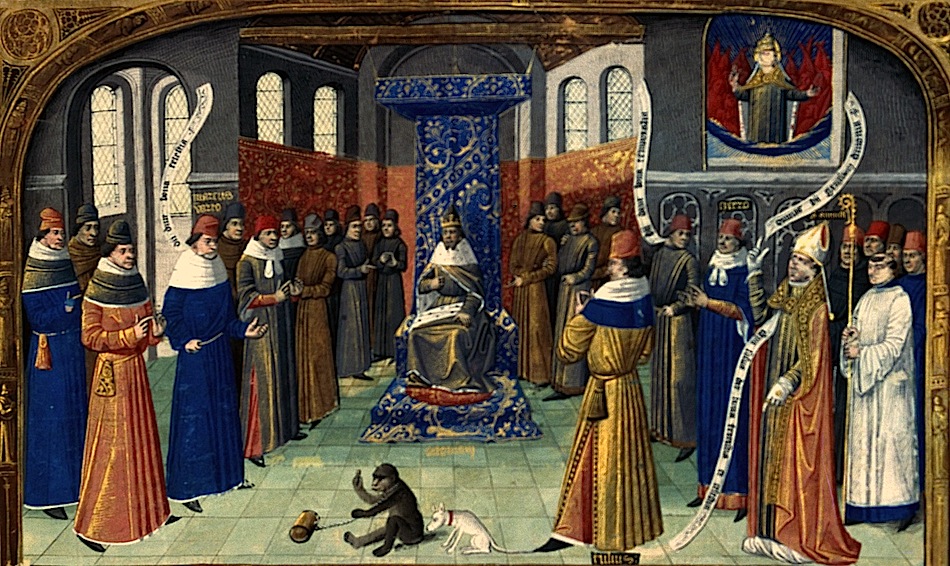
Today when we hear about the Marshalsea we think of the infamous 19th century Southwark prison with all its associated tortures. But come back with me to the 14th century and you’ll see that the word has a totally different meaning—at first, anyway. Originally, the marshalsea (not capitalized—also known as the avenary) was the largest department of the household, in charge of taking care of the horses: feeding, grooming, and stabling. At the same time, the Marshal was a great officer of the royal and noble household, who functioned as the enforcer—the policeman, if you will—and the jailer. Where the Marshalsea (capitalized) came into play was in relation to the court of the verge (or the court of the steward and Marshal of the household). The steward presided over the court of the verge and the Marshal enforced its will.
The Marshalsea court can be traced back to the second half of Edward I’s reign; it was the legal arm of the household. In practice it tried cases involving servants of the crown, whether sinning or sinned against: theft, debts, contracts, acts against the royal dignity, and trespassing—anything short of murder. This involved activity that took place within the verge, which was a twelve mile radius from the king’s presence. If anyone refused to cooperate with the king’s servants—such as Purveyors—they could be tried at the Marshalsea court. Interfering with Purveyors was one of the bigger offenses. Their job was to gather supplies for the itinerant court, such as food, wood for heating, oats and hay for the horses, etc. and these purchases were almost always a bone of contention. They rarely paid in cash; instead, they often gave the long-suffering supplier a note to be cashed at the exchequer—when the funds were available, that is. The supplier could wait months to get paid, if he got paid at all. But if that long-suffering merchant refused to contribute, the penalty could be severe. At the same time, the steward investigated complaints of extortionate behavior by the king’s servitors, though one can only wonder how often they decided in favor of the offended party.
Cases tried in the Marshalsea court were exempted from the common law courts; it became a separate tribunal, free from the technicalities and costs of traditional courts. Because of the itinerant nature of the king’s household, cases had to be tried quickly. Pleas of trespass and debt concerning outsiders often reverted back to the common law courts if the king moved on, taking the verge with him. Within the verge local officials were forbidden to trespass on the duties of the king’s officers; at the same time, they were found guilty of “contempt of the king” if they permitted the escape of suspected felons. There were plenty of conflicts between the local municipalities who wanted to try their own cases and who temporarily fell within the verge, and the government which didn’t always mind the boundaries.
Needless to say, the Londoners were often within the influence of the Marshalsea since the king was frequently in or near the city. Criminals were known to have crossed the Thames to Southwark to avoid punishment, since they could not be brought before the city authorities when the Marshalsea was present. The government tried to extend the Marshalsea’s jurisdiction into the city of London, but this was violently resisted and eventually dropped. Nonetheless, many formal protests were raised in successive Parliaments well into Henry IV’s reign. In 1373 Edward III ordered a building 40 feet long and 30 feet wide to be constructed “in the high street” for his own convenience, to hold pleas, keep prisoners, and hold other king’s courts. It was one of the first of London’s symbols of oppression to suffer the wrath of the Peasant’s Revolt, though it was rebuilt the following year. The king’s sergeant-at-arms and keeper of the Marshalsea, Richard Imworth, was brutally murdered by the rebels two days after they destroyed the prison.
As time went on, reportedly by 1430, the Marshalsea became known as a debtor’s prison, and was notorious by the 18th century, when it was rebuilt about 130 yards south of its original site. You can learn all about it from Charles Dickens whose father was imprisoned there in 1824.
Christopher Monk says:
Thank you. That was excellent. Very informative.
Mercedes Rochelle says:
Quite a compliment from you! Thanks, Christopher.